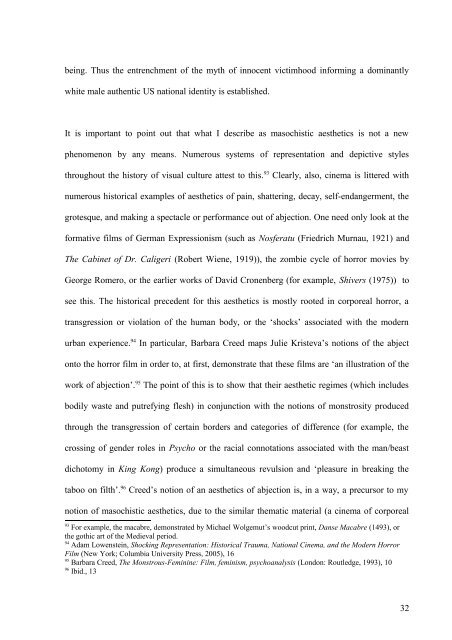the damaged male and the contemporary american war film
the damaged male and the contemporary american war film
the damaged male and the contemporary american war film
You also want an ePaper? Increase the reach of your titles
YUMPU automatically turns print PDFs into web optimized ePapers that Google loves.
eing. Thus <strong>the</strong> entrenchment of <strong>the</strong> myth of innocent victimhood informing a dominantly<br />
white <strong>male</strong> au<strong>the</strong>ntic US national identity is established.<br />
It is important to point out that what I describe as masochistic aes<strong>the</strong>tics is not a new<br />
phenomenon by any means. Numerous systems of representation <strong>and</strong> depictive styles<br />
throughout <strong>the</strong> history of visual culture attest to this. 93 Clearly, also, cinema is littered with<br />
numerous historical examples of aes<strong>the</strong>tics of pain, shattering, decay, self-endangerment, <strong>the</strong><br />
grotesque, <strong>and</strong> making a spectacle or performance out of abjection. One need only look at <strong>the</strong><br />
formative <strong>film</strong>s of German Expressionism (such as Nosferatu (Friedrich Murnau, 1921) <strong>and</strong><br />
The Cabinet of Dr. Caligeri (Robert Wiene, 1919)), <strong>the</strong> zombie cycle of horror movies by<br />
George Romero, or <strong>the</strong> earlier works of David Cronenberg (for example, Shivers (1975)) to<br />
see this. The historical precedent for this aes<strong>the</strong>tics is mostly rooted in corporeal horror, a<br />
transgression or violation of <strong>the</strong> human body, or <strong>the</strong> ‘shocks’ associated with <strong>the</strong> modern<br />
urban experience. 94 In particular, Barbara Creed maps Julie Kristeva’s notions of <strong>the</strong> abject<br />
onto <strong>the</strong> horror <strong>film</strong> in order to, at first, demonstrate that <strong>the</strong>se <strong>film</strong>s are ‘an illustration of <strong>the</strong><br />
work of abjection’. 95 The point of this is to show that <strong>the</strong>ir aes<strong>the</strong>tic regimes (which includes<br />
bodily waste <strong>and</strong> putrefying flesh) in conjunction with <strong>the</strong> notions of monstrosity produced<br />
through <strong>the</strong> transgression of certain borders <strong>and</strong> categories of difference (for example, <strong>the</strong><br />
crossing of gender roles in Psycho or <strong>the</strong> racial connotations associated with <strong>the</strong> man/beast<br />
dichotomy in King Kong) produce a simultaneous revulsion <strong>and</strong> ‘pleasure in breaking <strong>the</strong><br />
taboo on filth’. 96 Creed’s notion of an aes<strong>the</strong>tics of abjection is, in a way, a precursor to my<br />
notion of masochistic aes<strong>the</strong>tics, due to <strong>the</strong> similar <strong>the</strong>matic material (a cinema of corporeal<br />
93 For example, <strong>the</strong> macabre, demonstrated by Michael Wolgemut’s woodcut print, Danse Macabre (1493), or<br />
<strong>the</strong> gothic art of <strong>the</strong> Medieval period.<br />
94 Adam Lowenstein, Shocking Representation: Historical Trauma, National Cinema, <strong>and</strong> <strong>the</strong> Modern Horror<br />
Film (New York; Columbia University Press, 2005), 16<br />
95 Barbara Creed, The Monstrous-Feminine: Film, feminism, psychoanalysis (London: Routledge, 1993), 10<br />
96 Ibid., 13<br />
32

















